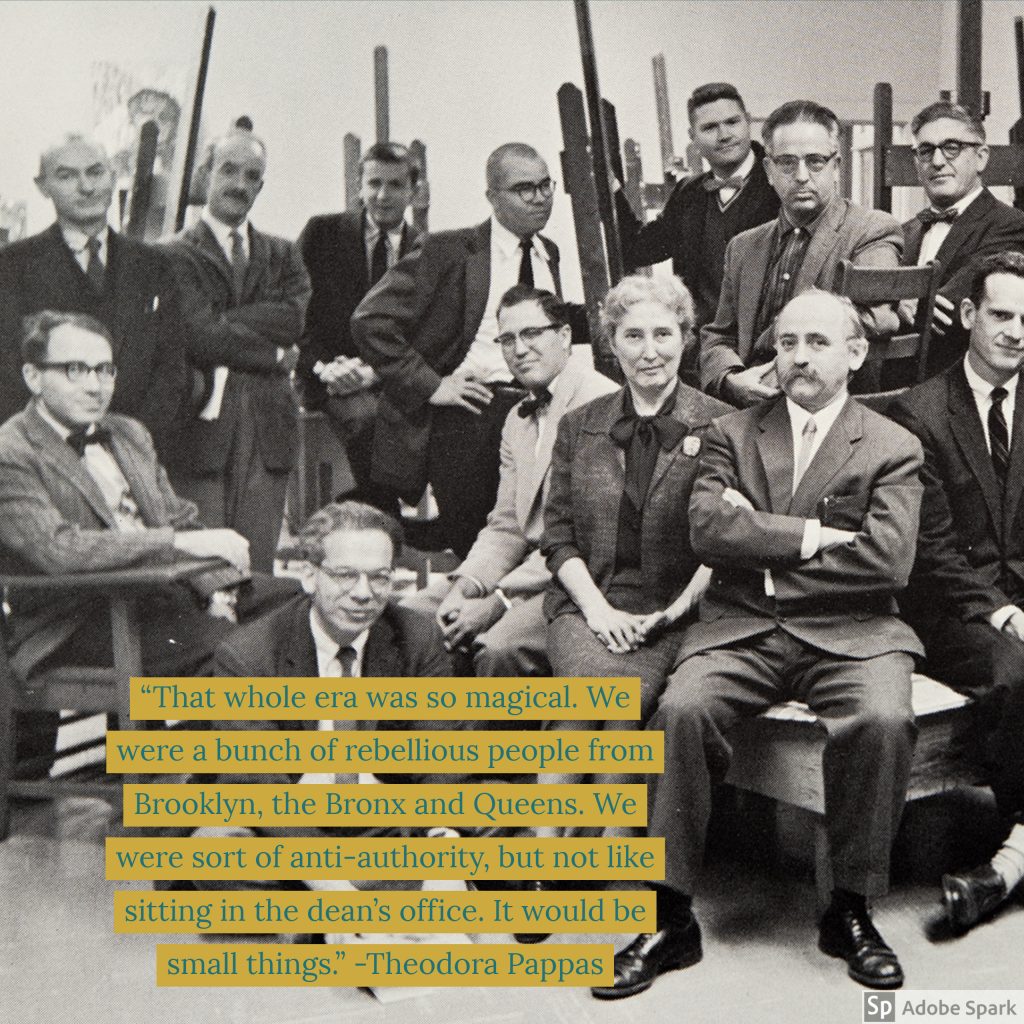Written by Jared Van Houten
Edited and Packaged by Tom McCarthy
Students in Professor Lindsay Lennon’s Feature Writing class were assigned interviews with SUNY New Paltz alumni who were featured in Wired Gallery’s “Golden Age of New Paltz” exhibition. This is what they found:
Theodora Pappas walked into the Atrium at SUNY New Paltz on a warm September afternoon. After a quick hello and introduction, she walked upstairs into the Student Union Building to find a quiet place to chat, a place filled with memories for her and her golden age compatriots. She sat down and began to tell of a simple time when young dreamers made art together. This was known as the Golden Age of New Paltz.
What was it like to be a part of the Golden Age of New Paltz?
Oh, it was magic. That whole era was so magical. We were a bunch of rebellious people from Brooklyn, the Bronx and Queens. We were sort of anti-authority, but not like sitting in the dean’s office. It would be small things. Like the dean’s first name was Jack. So sometimes when the dean would walk through the Student Union Building, one of us would go to the jukebox and put in money for “Hit the Road Jack.” But we did a lot of artwork. The buildings weren’t new. We worked in the TA Buildings, which stood for “Temporary Art Buildings.” These were actually old chicken coops, which had been sanitized, of course, and I think the chicken wire had been taken out. Those old buildings were great because it didn’t matter. You could fling paint on the walls, and you could plaster all over the place, because who cared? We would also go to the town dump and pick up stuff for our art, because sometimes the teachers would want us to do things with “found objects.” You could do anything you wanted and none of the art teachers would tell you that it wasn’t art. My sculpture teacher told me, “If you say that’s art, that’s art.” You feel good about things like that.

What are some things that you took away from your experience at New Paltz?
That if I say that something is art, it’s art. I haven’t thought about that saying in a very long time, but it was amazing to me when I first heard it. And it’s a very empowering and uplifting statement, especially if you’re young and don’t know what you’re doing (laughs). Also, don’t worry so much about making mistakes. If you make a mistake, use it. Use that coffee stain and incorporate it into your art.
What was your major?
Back then they didn’t give exact degrees like art. It could only be teaching. You could only get a teaching degree, so we became art teachers, music teachers, English teachers, etc. But you ended up with a B.S. You had to go to other places for an MFA. I guess to this day I’m still an art teacher.
How have you been using art in your life since New Paltz?
I’m a graphic designer, so commercial art. And sometimes I do sporadic things like a collage, or watercolors or mixes of things, but not as a constant everyday thing. But I have gotten to enjoy digital art.
What pushed you to do graphic design/digital art?
I needed a job. So I went and got a job at the Middletown Times Herald Record. They taught me how to lay out a paper, how to chop it, how to take things from the front and the back, etc. So then I moved to the city and got a job at Time Inc., as it was called then. I was a layout designer and worked hard to work my way up. I looked at the other people around and learned from them, as well as having the boss show me some things. We did promotions for the five magazines that Time had at the time. That’s what made me start doing what I do, promotions for magazines, as well as web ads.
With your teaching degree, did you ever teach art out of college?
Five days. Well, 10 altogether. I was a temp in New York City at a junior high in Harlem. We didn’t get along well at all because the kids didn’t sit down like they were supposed to. I wasn’t cut out for that, although some of my friends were and went on to be very good teachers. I kind of decided that wasn’t for me. We didn’t have any supplies because the city didn’t give us any supplies. I had to make my own glue for my students. So a friend of mine was working at Time Inc., and told me, “Come on over. They’re hiring!” That’s how I moved on from teaching to Time Inc., and began my journey to who I am now.
Read more about The Golden Age of New Paltz here:
Jack Murphy offers a snapshot of what it was like to be an artist in New Paltz during the “Golden Age,” and his inspiration behind curating the exhibition.
Jo-Ellen Trilling is an artist from the era of protest art in 1968 to 1971 who intertwines magical realism with art to reflect life within the political climate at the time.
Ed Samuels began drawing early in his childhood after being influenced by his family of artists. He found his niche during the ‘60s and ‘70s after seeing the beauty in all environments, from New York City streets to Sante Fe’s cliffs and beaches.
Jon Ellis Stevens is an award-winning photographer and New Paltz alumnus. He discusses his desire to show that photography is more than capturing still images and how the radical times of the ‘60s inspires his artwork.
Sevan Melikyan is a native from Turkey who journeyed with the dream of becoming an artist to America, where he became enthralled with the rich artistic history of New Paltz.
Eileen Cowin is a multi-medium artist from New York who creates politically charged work inspired by the 1970s and today and connects them in abstract ways.
Shelley Davis is a woman of many art forms, including a style she created herself as a graduate student. Her groundbreaking “photo fusion” art has travelled the globe, featured in galleries across Europe and the United States.
Robert Crimi is an artist from the Bronx who is inspired by jazz music and creates colorful oil paintings with techniques his muralist uncle taught him.
Rosalie Rossi, an alumna of SUNY New Paltz, has taught art to students from preschool to the college level. She believes every student she teaches should do a self portrait.
Michael Velkovich, an alumnus of SUNY New Paltz, uses printmaking to express his artistic vision. He reflects on his journey as an artist, how he faced critics and how he has given back to the arts community.
Aletta Vett is a costume designer who defied rules and honed her craft at New Paltz. Her art designs prove just how creative and talented she has been over her decades-long career.
Win Bottum-Morgan took a drawing class hoping to learn the mechanics of art but was instead taught how to see the world in a different light. This perspective ignited his passion for painting. He continues to pursue art while practicing as a clinical psychologist in Corte Madera, California.
Larry Audette, not only an artist but a Jazz musician, talks about his memorable time at New Paltz with an array of artists who felt like family to him.
Rosalind “Roz” Zarr creates wearable art. Her jewelry is the only of its medium featured in the “Golden Age of New Paltz,” a testament of her prolific experience at the university in the late ’60s.
